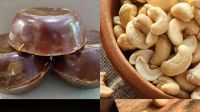Sugar palm (Arenga pinnata), also known as Kaong in the Indonesia, is an economically important tropical Asian feather palm. When mature, it is a medium-sized palm with a height of 12 to 15 m and a diameter of 40 cm (more than 15 years). It has up to 8.5 m long ascending pinnate leaves with 100 or more pairs of linear leaflets. When the plant reaches maturity, massive fruit clusters appear. The male flower is purple and has an unpleasant odor. It grows in a dense cluster 4 feet long. Female flower clusters are longer than male flower clusters and ripen slowly into glossy, brown, plum-sized fruit. Each new flower cluster develops on a leaf axil.The entire spectacle ends when flowering reaches the lowest leaf axil and the fruit ripens, and the plant dies. Fruits are always available on the trees during this period because each flower takes approximately 2 to 5 years to mature into a ripe fruit. Arenga pinnata has densely packed green nuts that turn yellow when mature. Fruits have a diameter of about 5 cm and 2 to 3 seeds
Sugar Production
Sugar is produced by boiling its sweet, unfermented sap. To avoid rapid fermentation, the sap is collected using a different sap receiver (bamboo joint) each day. Crushed ginger or chili pepper in the receiver also prevents rapid fermentation. Sap is typically thickened into a desirable consistency by boiling in an open kettle. If the liquid solidifies when dropped on a cool surface, it has reached the proper size and mixture. The sugar produced is brown, similar to that of the buri palm.








